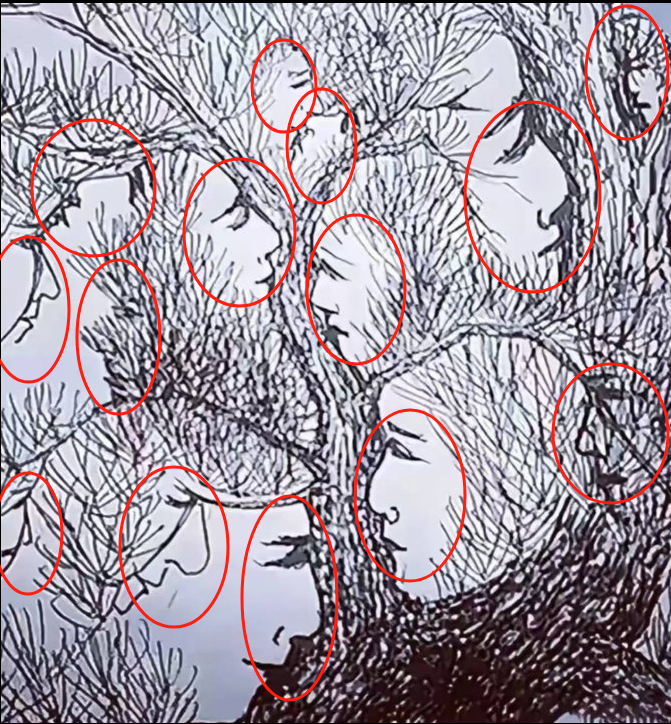The Enchanting Forest of Faces: Decoding a Mystical Tree Illusion
The Allure of Optical Illusions in Nature
Have you ever glanced at a gnarled tree and suddenly “seen” a face staring back? That magical moment when your brain shifts gears from “just branches” to “human profile” highlights the power of optical illusions—especially those hidden in nature. Our featured image is a breathtaking example: an intricately drawn tree whose twisting limbs and clusters of foliage create multiple human faces, each whispering its own story. This kind of art taps into a phenomenon called pareidolia, where we instinctively spot meaningful patterns (often faces) in random shapes. Intrigued? Let’s wander deeper down this winding path of perception and creativity.

What Is Pareidolia and Why Do We See Faces?
Pareidolia arises from the brain’s remarkable pattern-recognition system—one that evolved to detect friendly (or not-so-friendly) faces in the wild. When we glimpse a brief shape in the forest, our survival instincts kick in: “Is that a human? An animal? A predator?” Today, that impulse lingers, urging us to find faces in clouds, grill marks, and, yes, tree bark. In our tree illusion, the artist cleverly manipulates lines and empty space so that each branch bend becomes a forehead, each cluster of needles a cascade of hair. The result? A hauntingly beautiful forest populated by silent silhouettes.
Decoding the Faces: A Guided Discovery
At first glance, you might spot two prominent profiles locked in a gentle gaze near the center. But give your eyes time to adjust, and you’ll uncover more:
- Lovers’ Embrace: In the heart of the trunk, two faces—one masculine, one feminine—seem to lean in for an ethereal kiss. Their brows and noses flow seamlessly from bark to branch.
- Hidden Elders: High among the thinner twigs, faint outlines of older faces peer down, their beards and wrinkles etched by fine lines that mimic delicate branches.
- Whispering Youth: Closer to the roots, a pair of youthful profiles huddle, as if sharing a secret beneath the canopy.
Each discovery feels like stumbling upon a hidden glade—quiet, mysterious, and utterly captivating.
The Artistry Behind the Illusion
Creating a convincing tree-face illusion demands both technical skill and poetic vision. Here’s how artists achieve this balancing act:
- Mastering Negative Space
The white areas between branches act as sculpted voids that define facial features. By carefully carving these “blank” zones, an artist transforms emptiness into expressive eyes, cheeks, and lips. - Harmonizing Texture and Contour
Rough bark textures morph into stubbly beards or wild hair. Smooth branch curves become noses and chins. The interplay ensures that no matter how you focus, your brain can toggle between “tree” and “face.” - Layering Depth with Line Weight
Heavier, darker strokes ground the main faces in the foreground, while lighter, finer lines sketch secondary profiles deeper in the foliage. This layering gives the illusion dimensionality, as if faces peek out from behind leafy veils.
Why Our Brains Crave Visual Puzzles
Spotting hidden faces does more than wow our friends—it actually lights up reward centers in our brain. Here’s why we can’t get enough of these illusions:
- Mental Workout: Searching for subtle patterns sharpens attention and forces us to switch between big-picture scanning and micro-analysis.
- Mood Booster: That “Aha!” moment releases dopamine, giving us a mini-celebration in the mind.
- Creative Fuel: Encountering one illusion often sparks inspiration for new ideas, whether you’re a writer crafting metaphors or a designer sketching fresh motifs.

- Wall Art: Commission or print a large-format illusion for a living room focal point—guests will love peering into its hidden depths.
- Decorative Panels: Laser-cut wooden screens featuring subtle face illusions can serve as room dividers, letting light and mystery filter through.
- Textile Designs: From throw pillows to duvet covers, intricate line-work prints bring a playful, dreamlike quality to soft furnishings.
- DIY Sketch Corner: Keep a small sketchbook by your favorite window. Try translating bark patterns you see outdoors into quick face-in-tree doodles.
- How to Create Your Own Tree Face Illusion
Thinking of crafting your own? Here’s a quick roadmap:- Select a Strong Tree Silhouette
Choose a reference photo—one with bold, twisting branches and interesting bark texture. - Outline Primary Profiles
Lightly sketch where the main faces will appear. Remember to align noses and chins with natural branch curves. - Blend Branches into Features
Morph branches into eyebrows, the trunk into foreheads, and roots into jawlines. Be subtle—over-defined shapes break the illusion. - Add Secondary Faces
Use thinner twigs and sparse leaf clusters for background profiles. Keep these features lighter so they recede visually. - Refine with Negative Space
Erase or whiten carefully around facial contours to sharpen the distinction between “face” and “tree.”
The Emotional Power of Hidden Faces
Beyond technical flair, these illusions touch something deep in us: the desire for connection. Each face seems to watch silently, almost beckoning us to remember that every tree, every corner of nature, holds stories we’re only just beginning to learn. In those silent, leafy observants we find metaphors for our own hidden depths.
- Select a Strong Tree Silhouette
- Conclusion: Celebrate the Whispering Woods
The enchanting tree-face illusion invites us into a world where art and nature entwine, where every twist of branch might harbor a hidden soul. By exploring pareidolia, understanding the artistry, and even crafting our own visual riddles, we deepen our appreciation for both creative expression and the natural world. So next time you stroll beneath a canopy or study a scribbled sketch, pause and look again—your own forest of faces may be waiting, ready to whisper secrets you never knew were there.